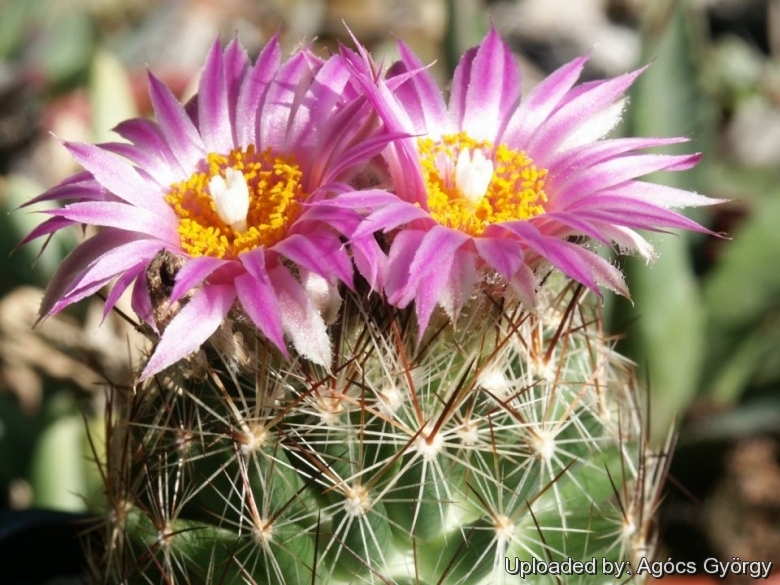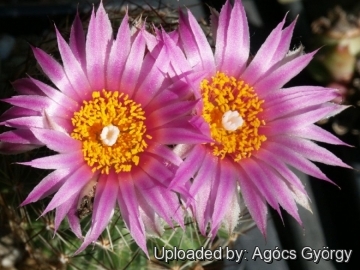Accepted Scientific Name: Coryphantha vivipara var. neomexicana (Engelm.) Backeb.

Escobaria vivipara var. borealis Photo by: Agócs György
Field number HK 1958, Manzano Mts. New Mexico. Rebutialand cactus collection Demjén, Hungary.
Origin and Habitat: New Mexico.
Synonyms:
Common Names include:
ENGLISH: New Mexico Spinystar, New Mexico Pincushion Cactus
Description: Escobaria viviparaSN|10274]]SN|9953]] is a small solitary or clumping cactus, some varieties forming colonies of over 200 stems. This species is the most widespread, abundant and variable member of the genus.
Remarks: The “borealis” variety is a controversial name that has sunk into complete obscurity and considered by some authors synonymous with Escobaria viviparaSN|9953]]SN|9953]] var. neomexicana. Perhaps the name "borealis" (of the north) was originally intended for the strange very northern vivipara that have very open spination and look somewhat more like Escobaria missouriensisSN|9953]]SN|10274]], but this northern form never seem to have acquired a name.
Stem: Usually more than 1/2 above ground ovoid, obovoid, or cylindric with age to 9.5 x 7cm.
Tubercles: Grooved, stiff or ± flaccid 12-16 mm long; areolar glands absent.
Radial Spines: 20-30 per areole; white to cremy-white often with pinkish tips hardly distinguishable from centrals.
Central spines: 3-4 per areole, straight, spreading slightly longer than radials.
Flowers: Subapical, rose-pink to reddish pink, violet or magenta with darker midstripes.
Fruits: Green, exposed portions slowly turning dull brownish red, ovoid to obovoid, juicy; floral remnant persistent.
Seeds: Bright reddish brown.
Blooming season: Spring-late summer; fruiting 2-5 months after flowering.
Subspecies, varieties, forms and cultivars of plants belonging to the Escobaria vivipara group
Bibliography: Major references and further lectures
1) Edward Anderson “The Cactus family” Timber Press, Incorporated, 2001
2) Terry, M., Heil, K. & Corral-Díaz, R. 2013. Escobaria vivipara. The IUCN Red List of Threatened Species. Version 2015.1. <www.iucnredlist.org>. Downloaded on 13 June 2015.
3) James Cullen, Sabina G. Knees, H. Suzanne Cubey "The European Garden Flora Flowering Plants: A Manual for the Identification of Plants Cultivated in Europe, Both Out-of-Doors and Under Glass" Cambridge University Press, 11/Aug/2011
4) David R Hunt; Nigel P Taylor; Graham Charles; International Cactaceae Systematics Group. "The New Cactus Lexicon" dh books, 2006
5) Castetter, E.F., P. Pierce and K.H. Schwerin. “Reassessment of the genus Escobaria.” Cactus and Succulent Journal (US) 47(2):60-70.1975.
6) Leo J. Chance “Cacti and Succulents for Cold Climates: 274 Outstanding Species for Challenging Conditions” Timber Press, 19/giu/2012
7) N. L. Britton, J. N. Rose “The Cactaceae. Descriptions and Illustrations of Plants of the Cactus Family.” Volume 4, The Carnegie Institution of Washington, Washington 1923
8) Flora of North America Editorial Committee. “Flora of North America, volume 4.” Oxford University Press, New York.2003.
 Field number HK 1958, Manzano Mts. New Mexico. Rebutialand cactus collection Demjén, Hungary. Photo by: Agócs György
Field number HK 1958, Manzano Mts. New Mexico. Rebutialand cactus collection Demjén, Hungary. Photo by: Agócs GyörgySend a photo of this plant.The gallery now contains thousands of pictures, however it is possible to do even more. We are, of course, seeking photos of species not yet shown in the gallery but not only that, we are also looking for better pictures than those already present.
Read More...











